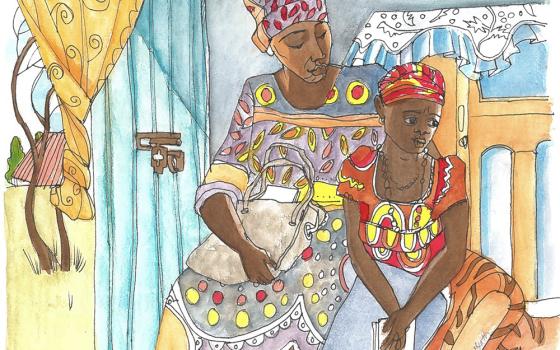
The first film that impressed itself on my memory in an indelible way was John Ford’s “The Searchers.” I was just 7 when I saw it for 10 cents at the San Diego Recreation Center in our neighborhood. I remember sitting on a folding chair, gripping the sides in terror when the Indian chief Cicatriz (Henry Brandon) stole little Debbie (Lana Wood) who was hiding behind her grandmother’s grave marker. To this day, “The Searchers” remains at the top of my favorite film list.
This journey down memory lane is by way at arriving at John Wayne’s Oscar-winning role as the reluctant hero Rooster Cogburn in director Henry Hathaway’s 1969 classic “True Grit.” The film was based, very closely, on Charles Portis’ 1968 novel. The screenplay was written by Marguerite Roberts, who wrote 34 screenplays in her career, even after being blacklisted in 1952 for refusing to name names when interrogated by the House Committee for Un-American Activities.
“True Grit” is the tale of a girl, Mattie Ross, whose father is killed in Fort Smith, Ark., in cold blood by Tom Chaney, a man her father hired out of kindness. Mattie is determined to find Chaney and see him brought to justice. She sends her father’s body home with the hired man Yarnell and sets about to find the right man to track down Chaney.
She is told that Marshall Rooster Cogburn has “true grit” even though he only has one eye. She seeks him out, talks him into shape (he is often drunk), and insists that she go along with him. La Boeuf, a freelancing Texas Ranger, shows up because he, too, is looking for Chaney, who shot a Texas senator. The two men try to leave without Mattie, but she catches up and their adventure begins.
Now there’s a new telling of “True Grit” by arguably the most interesting directors in the business, Ethan and Joel Coen. They did not want to remake the original film version, but wanted to keep as close to the book as possible. Both films use the plot and characters and extensive dialogue directly from the novel.
The soundtracks for both films are Christian in nature, from “Amazing Grace” at the lynching in Hathaway’s version to “Leaning on the Everlasting Arms,” a Gospel hymn published in 1887, in the Coen version.
Mattie Ross narrates the story in the novel and the Coen film, reclaiming the personal point of view. The story belongs to Mattie, who is seeking retribution for her father’s death. On the 1969 poster, the image of John Wayne dominates and the text says: “Everyone on both sides of the law was afraid of Rooster Cogburn ...” The poster for the Coen film has “Punishment comes one way or another,” and at the theater where I saw the film, “Retribution” heads the poster. There is talk of justice and lots of scripture-quoting throughout both films, but the theme is frontier justice fueled by vengeance cached in being a Christian American.
This theme is reinforced by the snake, symbol of evil rising out of the chest of a dead man, where the heart is. But why does the snake bite Mattie, a stalwart frontier woman and the key character in the story, and cause her to lose her arm? Why is she punished and not the men? Why is she vulnerable?
Is it because the author is saying frontier justice is just as lawless as the free-range criminals of the Wild West period and that it is not authentically Christian? That justice is not the same as vengeance and that conflating the terms into the same idea has a price?
I think that Portis created a Western heroine in the mold of the many characters that Wayne played. At the same time she is a caricature of those “heroes.” Wayne became an icon of American individualism, a man who can and will go it alone to tame the natural and social environment to which he is entitled. Young Mattie is a wonderfully entertaining character, but the mature woman is solitary, fiercely independent, determined, strong, intelligent and, of course, Christian.
Grit, vengeance and justice are American virtues, but Portis and the Coen brothers show that these are flawed ideals.
The final scene in the new film parallels perfectly with the closing scene in “The Searchers.” Mattie walks off alone, a woman who has never married, her straight, strong back to the screen. In “The Searchers,” John Wayne’s Ethan, tired and worn, walks out of the cabin, back to the screen, task accomplished, the solitary man who can go it alone. Both films conclude with the hero walking away to whatever will come next.
The Coen brothers’ film can be examined through the music, the cinematography, and racism that the original film avoids. The influence of the Western, even a new version of a quirky one, has something to say about who we are as Americans today.
John Wayne deserved an Oscar for “The Searchers,” where he played against type by changing. He was determined to kill his niece, who had grown up with the Comanche Indians and had probably married one, but in the end, he embraced her and brought her home. It is a film that is more appreciated now than it was at the time.
In “True Grit,” John Wayne’s Rooster wore his patch on his left eye, and Jeff Bridges’ on his right. Either way, frontier justice is, at best and at worst, half blind.
[Sr. Rose Pacatte, a member of the Daughters of St. Paul, is director of the Pauline Center for Media Studies in Los Angeles.]



